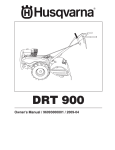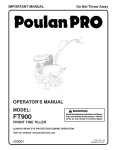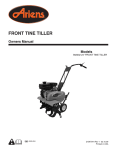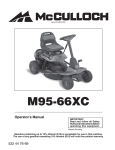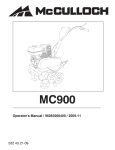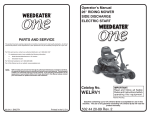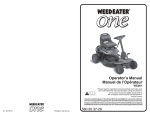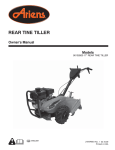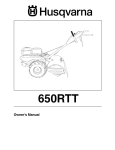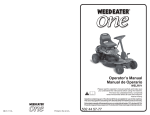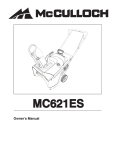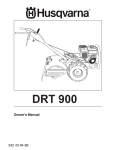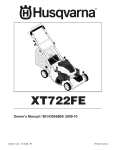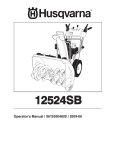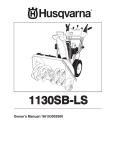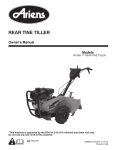Download Husqvarna RTT900 Tiller User Manual
Transcript
RTT900 Owner's Manual / 96093000903 / 2009-04 SAFETY RULES Safe Operation Practices for Walk-Behind Powered Rotary Tillers TRAINING • • • • Read the Manual carefully. Be thoroughly familiar with the controls and the proper use of the equipment. Know how to stop the unit and disengage the controls quickly. Never allow children to operate the equipment. Never allow adults to operate the equipment without proper instruction. Keep the area of operation clear of all persons, particularly small children, and pets. • • • • • • • PREPARATION • • • • • • • • • • Thoroughly inspect the area where the equipment is to be used and remove all foreign objects. Disengage all clutches and shift into neutral before starting the engine (motor). Do not operate the equipment without wearing adequate outer garments. Wear footwear that will improve footing on slippery surfaces. Handle fuel with care; it is highly flammable. Use an approved fuel container. Never add fuel to a running engine or hot engine. Fill fuel tank outdoors with extreme care. Never fill fuel tank indoors. Replace gasoline cap securely and clean up spilled fuel before restarting. Use extension cords and receptacles as specified by the manufacturer for all units with electric drive motors or electric starting motors. Never attempt to make any adjustments while the engine (motor) is running (except where specifically recommended by manufacturer). MAINTENANCE AND STORAGE • • • • • • • • • • • Keep machine, attachments, and accessories in safe working condition. Check shear pins, engine mounting bolts, and other bolts at frequent intervals for proper tightness to be sure the equipment is in safe working condition. Never store the machine with fuel in the fuel tank inside a building where ignition sources are present, such as hot water and space heaters, clothes dryers, and the like. Allow the engine to cool before storing in any enclosure. Always refer to the operator’s guide instructions for important details if the tiller is to be stored for an extended period. - IMPORTANT CAUTIONS, IMPORTANTS, AND NOTES ARE A MEANS OF ATTRACTING ATTENTION TO IMPORTANT OR CRITICAL INFORMATION IN THIS MANUAL. IMPORTANT: USED TO ALERT YOU THAT THERE IS A POSSIBILITY OF DAMAGING THIS EQUIPMENT. OPERATION • • Never operate the tiller without proper guards, plates, or other safety protective devices in place. Keep children and pets away. Do not overload the machine capacity by attempting to till too deep at too fast a rate. Never operate the machine at high speeds on slippery surfaces. Look behind and use care when backing. Never allow bystanders near the unit. Use only attachments and accessories approved by the manufacturer of the tiller. Never operate the tiller without good visibility or light. Be careful when tilling in hard ground. The tines may catch in the ground and propel the tiller forward. If this occurs, let go of the handlebars and do not restrain the machine. Do not put hands or feet near or under rotating parts. Exercise extreme caution when operating on or crossing gravel drives, walks, or roads. Stay alert for hidden hazards or traffic. Do not carry passengers. After striking a foreign object, stop the engine (motor), remove the wire from the spark plug, thoroughly inspect the tiller for any damage, and repair the damage before restarting and operating the tiller. Exercise caution to avoid slipping or falling. If the unit should start to vibrate abnormally, stop the engine (motor) and check immediately for the cause. Vibration is generally a warning of trouble. Stop the engine (motor) when leaving the operating position. Take all possible precautions when leaving the machine unattended. Disengage the tines, shift into neutral, and stop the engine. Before cleaning, repairing, or inspecting, shut off the engine and make certain all moving parts have stopped. Disconnect the spark plug wire, and keep the wire away from the plug to prevent accidental starting. Disconnect the cord on electric motors. Do not run the engine indoors; exhaust fumes are dangerous. NOTE: Gives essential information that will aid you to better understand, incorporate, or execute a particular set of instructions. Look for this symbol to point out important safety precautions. It means CAUTION!!! BECOME ALERT!!! YOUR SAFETY IS INVOLVED. CAUTION: Always disconnect spark plug wire and place wire where it cannot contact spark plug in order to prevent accidental starting when setting up, transporting, adjusting or making repairs. WARNING The engine exhaust from this product contains chemicals known to the State of California to cause cancer, birth defects, or other reproductive harm. 2 PRODUCT SPECIFICATIONS Gasolina Capacity: 3 Quarts (2.8L) Unleaded Regular Oil (API-SG-SL): (Capacity: 20 oz./0.6L) SAE 30 (Above 32°F) SAE 5W-30 (Below 32°F) Spark Plug : (Gap: .030"/0.76mm) NGK-BPR6ES TORCH-F6RTC CUSTOMER RESPONSIBILITIES • • Read and observe the safety rules. Follow a regular schedule in maintaining, caring for and using your tiller. • Follow instructions under “Maintenance” and “Storage” sections of this Owner’s Manual. WARNING: This unit is equipped with an internal combustion engine and should not be used on or near any unimproved forest-covered, brush-covered or grass covered land unless the engine's exhaust system is equipped with a spark arrester meeting applicable local laws (if any). If a spark arrester is used, it should be maintained in effective working order by the operator. In the state of California, a spark arrester is required by law (Section 4442 of the California Public Resources Code). Other states may have similar laws. Federal laws apply on federal lands. See your authorized service center/ DEPARTMENT for spark arrester. CONGRATULATIONS on your purchase of a new tiller. It has been designed, engineered and manufactured to give you the best possible dependability and performance. Should you experience any problems you cannot easily remedy, please contact your nearest authorized service center. We have competent, well-trained technicians and the proper tools to service or repair this unit. Please read and retain this manual. The instructions will enable you to assemble and maintain your tiller properly. Always observe the “SAFETY RULES”. TABLE OF CONTENTS SAFETY RULES ..........................................................2 CUSTOMER RESPONSIBILITIES...............................3 PRODUCT SPECIFICATIONS .....................................3 ASSEMBLY ...............................................................4-6 OPERATION ...........................................................7-11 MAINTENANCE SCHEDULE ....................................12 MAINTENANCE ...................................................12-14 SERVICE & ADJUSTMENTS ...............................15-17 STORAGE ..................................................................18 TROUBLESHOOTING ...............................................19 REPAIR PARTS ....................................................20-26 WARRANTY............................................. BACK PAGE 3 ASSEMBLY Your new tiller has been assembled at the factory with exception of those parts left unassembled for shipping purposes. To ensure safe and proper operation of your tiller all parts and hardware you assemble must be tightened securely. Use the correct tools as necessary to insure proper tightness. TOOLS REQUIRED FOR ASSEMBLY FRONT A socket wrench set will make assembly easier. Standard wrench sizes are listed. (1) Utility knife (1) Tire pressure gauge (1) Pair of pliers (1) 9/16" wrench LEFT RIGHT OPERATOR’S POSITION (See Fig. 1) When right or left hand is mentioned in this manual, it means when you are in the operating position (standing behind tiller handles). OPERATOR’S POSITION Fig. 1 CONTENTS OF HARDWARE PACK (1) Carriage Bolt 3/8-16 UNC x 1 Grade 5 (2) Handle Locks (1) Flat Washer 13/32 x 1 x 11 Gauge (1) Center Locknut 3/8-16 UNC (1) Handle Lock Lever (1) Pivot Bolt 3/8-16 UNC Grade 5 Extra Shear Pins & Clips 4 (1) Hairpin Clip ASSEMBLY UNPACKING CARTON (See Fig. 2) • CAUTION: Be careful of exposed staples when handling or disposing of cartoning material. Grasp handle assembly. Hold in “up” position. Be sure handle lock remains in gearcase notch. Slide handle assembly into position. HANDLE ASSEMBLY "UP" POSITION IMPORTANT: WHEN UNPACKING AND ASSEMBLING TILLER, BE CAREFUL NOT TO STRETCH OR KINK CABLES. • • • • • While holding handle assembly, cut cable ties securing handle assembly to top frame and depth stake. Let handle assembly rest on tiller. Remove top frame of carton. Slowly ease handle assembly up and place on top of carton. Cut down right hand front and right hand rear corners of carton, lay side carton wall down. Remove packing material from handle assembly. TIGHTEN HANDLE LOCK LEVER TO HOLD LOOSEN HANDLE LOCK LEVER TO MOVE Fig. 4 HANDLE ASSEMBLY • • • car • _3 ton • • SHIFT ROD • Fig. 2 • INSTALL HANDLE (See Figs. 3, 4, and 5) • Insert one handle lock (with teeth facing outward) in gearcase notch. (Apply grease on smooth side of handle lock to aid in keeping lock in place until handle assembly is lowered into position.) Rotate handle assembly down. Insert rear carriage bolt first, with bolt head on L.H. side of tiller and loosely assemble locknut (See Fig. 5). Insert pivot bolt in front part of plate and tighten. Cut down remaining corners of carton and lay panels flat. Lower the handle assembly. Tighten nut on carriage bolt so handle moves with some resistance. This will allow for easier adjustment. Place flat washer on threaded end of handle lock lever. Insert handle lock lever through handle base and gearcase. Screw in handle lock lever just enough to hold lever in place. Insert second handle lock (with teeth inward) in the slot of the handle base (just inside of washer). With handle assembly in lowest position, securely tighten handle lock lever by rotating clockwise. Leaving handle assembly in lowest position will make it easier to remove tiller from carton. HANDLE LOCK VIEWED FROM R.H. SIDE OF TILLER FLAT WASHER GEARCASE HANDLE ASSEMBLY SLOT HANDLE LOCK LEVER GEARCASE NOTCH HANDLE LOCK CARRIAGE BOLT les hand _34 PIVOT BOLT HANDLE BASE LOCKNUT Fig. 3 Fig. 5 5 ASSEMBLY CONNECT SHIFT ROD (See Fig. 7) ATTACH CLUTCH CABLE (See Fig. 6) • • • Hook end of clutch cable through hole in control bar bracket. CONTROL BAR BRACKET Insert end of shift rod into hole of shift lever indicator. Insert hairpin clip through hole of shift rod to secure. SHIFT ROD SHIFT LEVER INDICATOR HAIRPIN CLIP CONTROL BAR CLUTCH CABLE CONTROL BAR BRACKET Fig. 7 REMOVE TILLER FROM CRATE • END OF CLUTCH CABLE • Fig. 6 • Make sure shift lever indicator is in “N” position (See Fig. 7) Tilt tiller forward by lifting handle. Separate cardboard cover from leveling shield. Rotate tiller handle to the right and pull tiller out of carton. CHECK TIRE PRESSURE The tires on your unit were overinflated at the factory for shipping purposes. Correct and equal tire pressure is important for best tilling performance. • Reduce tire pressure to 20 PSI (1.4 kg/cm2). HANDLE HEIGHT • 6 Handle height may be adjusted to better suit operator. (See “TO ADJUST HANDLE HEIGHT” in the Service and Adjustments section of this manual). OPERATION KNOW YOUR TILLER READ THIS OWNER'S MANUAL AND SAFETY RULES BEFORE OPERATING YOUR TILLER. Compare the illustrations with your tiller to familiarize yourself with the location of various controls and adjustments. Save this manual for future reference. These symbols may appear on your Tiller or in literature supplied with the product. Learn and understand their meaning. THROTTLE CONTROL CHOKE CONTROL FUEL VALVE SHIFT LEVER ON/OFF SWITCH SHIFT LEVER INDICATOR DRIVE CONTROL BAR DEPTH STAKE LEVELING SHIELD Fig. 8 MEETS ANSI SAFETY REQUIREMENTS Our tillers conform to the safety standards of the American National Standards Institute. RECOIL STARTER HANDLE - Used to start the engine. SHIFT LEVER - Used to shift transmission gears. SHIFT LEVER INDICATOR - Shows which gear the transmission is in. THROTTLE CONTROL - Controls engine speed. CHOKE CONTROL - Used when starting a cold engine. DEPTH STAKE - Controls depth at which tiller will dig. DRIVE CONTROL BAR - Used to engage tines. LEVELING SHIELD - Levels tilled soil. ON / OFF switch - used to STOP the engine. FUEL VALVE - Used to turn fuel off and on. 7 OPERATION 00155 The operation of any tiller can result in foreign objects thrown into the eyes, which can result in severe eye damage. Always wear safety glasses or eye shields before starting your tiller and while tilling. We recommend a wide vision safety mask for over spectacles or standard safety glasses. HOW TO USE YOUR TILLER TINE OPERATION - WITH WHEEL DRIVE • Know how to operate all controls before adding fuel and oil or attempting to start engine. • STOPPING (See Fig. 9) Always release drive control bar before moving shift lever into another position. Tine movement is achieved by moving shift lever to ( ) till position and engaging drive control bar. TINES 1. Release drive control to stop movement. 2. Move shift lever to “N” (neutral) position. F O R W A R D - W H E E L S O N LY / T I N E S STOPPED ENGINE 2. Move throttle control to “SLOW” position and allow the engine to run slowly for cool down. 3. Turn the engine switch to the "OFF" Position. 4. Turn the fuel valve lever to the "OFF" Position. REVERSE STOPPED • • • • • • NOTE: NEVER USE CHOKE TO STOP ENGINE. IMPORTANT: TO STOP ENGINE IN AN EMERGENCY, TURN THE ENGINE SWITCH TO THE OFF POSITION. SHIFT LEVER Release drive control bar and move shift lever indicator to “F” (forward) position. Engage drive control bar and tiller will move forward. - WHEELS O N LY / T I N E S DO NOT STAND DIRECTLY BEHIND TILLER. Release the drive control bar. Move throttle control to “SLOW” position. Move shift lever indicator to “R” (reverse) position. Hold drive control bar against the handle to start tiller movement. HARD TO SHIFT GEARS • DRIVE CONTROL BAR “ENGAGED” POSITION DEPTH STAKE (See Fig. 10) The depth stake can be raised or lowered to allow you more versatile tilling and cultivating, or to more easily transport your tiller. DRIVE CONTROL BAR “DISENGAGED” POSITION THROTTLE CONTROL Briefly engage drive control bar and release or rock tiller forward and backward until are able to shift gears. ENGINE SWITCH FUEL VALVE 1 TRANSPORT POSITION SHALLOWEST TILLING (CULTIVATING) DEEPEST TILLING THROTTLE CONTROL DEPTH STAKE _2 ake _st pth Fig. 10 TILLING (See Fig. 11) FUEL VALVE • ENGINE SWITCH • • Fig. 9 8 Release depth stake pin. Pull the depth stake up for increased tilling depth. Place depth stake pin in hole of depth stake to lock in position. Place shift lever indicator in ( )till position. Hold the drive control bar against the handle to start tilling movement. Tines and wheels will both turn. OPERATION • Move throttle control to “FAST” position for deep tilling. To cultivate, throttle control can be set at any desired speed, depending on how fast or slow you wish to cultivate. • • AROUND TOWN • Disconnect spark plug wire. • Drain fuel tank. • Transport in upright position to prevent oil leakage. IMPORTANT: ALWAYS RELEASE DRIVE CONTROL BAR BEFORE MOVING SHIFT LEVER INTO ANOTHER POSITION. TURNING • • • • • • Hold the drive control bar against the handle to start tiller movement. Tines will not turn. Move throttle control to desired speed. Release the drive control bar. Move throttle control to “SLOW” position. Place shift lever indicator in “F” (forward) position. Tines will not turn. Lift handle to raise tines out of ground. Swing the handle in the opposite direction you wish to turn, being careful to keep feet and legs away from tines. When you have completed your turn-around, release the drive control bar and lower handle. Place shift lever in (till) position and move throttle control to desired speed. To begin tilling, hold drive control bar against the handle. BEFORE STARTING ENGINE IMPORTANT: BE VERY CAREFUL NOT TO ALLOW DIRT TO ENTER THE ENGINE WHEN CHECKING OR ADDING OIL OR FUEL. USE CLEAN OIL AND FUEL AND STORE IN APPROVED, CLEAN, COVERED CONTAINERS. USE CLEAN FILL FUNNELS. FILL ENGINE WITH OIL (See Fig. 12) 1. Remove hangtag from engine. 2. With engine level, remove engine oil filler plug. 3. Fill engine with oil to point of overflowing. For approximate capacity see “PRODUCT SPECIFICATIONS” on page 4 of this manual. All oil must meet A.P.I. Service Classification SG-SL. 4. Tilt tiller back on its wheels and then re-level. 5. With engine level, refill to point of overflowing if necessary. Replace oil filler plug. • For cold weather operation you should change oil for easier starting (See “OIL VISCOSITY CHART” in the Maintenance section of this manual). • To change engine oil, see the Maintenance section of this manual. DEPTH STAKE PIN “RELEASED” POSITION “LOCKED” POSITION Oil Filler Plug Oil Level de e_ ak st h_ pt 16 Fig. 11 TO TRANSPORT t_4 _ar ine eng CAUTION: Before lifting or transporting, allow tiller engine and muffler to cool. Disconnect spark plug wire. Drain gasoline from fuel tank. Max Upper Level Min Lower Level AROUND THE YARD • Release the depth stake pin. Move the depth stake down to the top hole for transporting the tiller. Place depth stake pin in hole of depth stake to lock in position. This prevents tines from scuffing the ground. • Place shift lever indicator in “F” (forward) position for transporting. Fig. 12 9 OPERATION ADD GASOLINE • TO START ENGINE (See Fig. 13) Fill fuel tank to bottom of filler neck. Do not overfill. Use fresh, clean, regular unleaded gasoline with a minimum of 87 octane. (Use of leaded gasoline will increase carbon and lead oxide deposits and reduce valve life). Do not mix oil with gasoline. Purchase fuel in quantities that can be used within 30 days to assure fuel freshness. CAUTION: KEEP TINE CONTROL IN “OFF” POSITION WHEN STARTING ENGINE. When starting engine for the first time or if engine has run out of fuel, it will take extra pulls of the recoil starter to move fuel from the tank to the engine. 1. Make sure spark plug wire is properly connected. 2. Place the fuel valve to the "ON" position. 3. To start a cold engine, move the choke lever to the "ON" position. 4. Move the throttle lever away from the "SLOW" position, about 1/3 of the way toward the "FAST" position. 5. Turn the engine switch to the "ON" position. Pull rope out slowly until engine reaches start of compression cycle (rope will pull slightly harder at this point). 6. Pull recoil starter handle quickly. Do not let starter handle snap back against starter. Repeat if necessary. CAUTION: Fill to within 1/2 inch of top of fuel tank to prevent spills and to allow for fuel expansion. If gasoline is accidentally spilled, move machine away from area of spill. Avoid creating any source of ignition until gasoline vapors have disappeared. Wipe off any spilled oil or fuel. Do not store, spill or use gasoline near an open flame. IMPORTANT: WHEN OPERATING IN TEMPERATURES BELOW32°F(0°C), USE FRESH, CLEAN WINTER GRADE GASOLINE TO HELP INSURE GOOD COLD WEATHER STARTING. NOTE: IF ENGINE FIRES BUT DOES NOT START, MOVE CHOKE CONTROL TO HALF CHOKE POSITION. PULL RECOIL STARTER HANDLE UNTIL ENGINE STARTS. 7. If the choke lever has been moved to the "ON" position to start the engine, gradually move it to the opposite position as the engine warms up. CAUTION: Alcohol blended fuels (called gasohol or using ethanol or methanol) can attract moisture which leads to separation and formation of acids during storage. Acidic gas can damage the fuel system of an engine while in storage. To avoid engine problems, the fuel system should be emptied before storage of 30 days or longer. Drain the gas tank, start the engine and let it run until the fuel lines and carburetor are empty. Use fresh fuel next season. See Storage Instructions for additional information. Never use engine or carburetor cleaner products in the fuel tank or permanent damage may occur. NOTE: A WARM ENGINE REQUIRES LESS CHOKING TO START. 8. Move throttle control to desired running position. 9. Allow engine to warm up for a few minutes before engaging tines. NOTE: IF ENGINE DOES NOT START, SEE TROUBLESHOOTING POINTS. Fuel Valve Spark Plug Throttle Control Choke Control Recoil Starter Fig. 13 10 Engine Switch OPERATION TILLING HINTS CULTIVATING Cultivating is destroying the weeds between rows to prevent them from robbing nourishment and moisture from the plants. At the same time, breaking up the upper layer of soil crust will help retain moisture in the soil. Best digging depth is 1" to 3" (2.5-7.5 cm). Lower the outer side shields to protect small plants from being buried. • Cultivate up and down the rows at a speed which will allow tines to uproot weeds and leave the ground in rough condition, promoting no further growth of weeds and grass (See Fig. 15). CAUTION: Until you are accustomed to handling your tiller, start actual field use with throttle in slow position (mid-way between “FAST” and “IDLE”). • • • • Tilling is digging into, turning over, and breaking up packed soil before planting. Loose, unpacked soil helps root growth. Best tilling depth is 4" to 6" (10-15 cm). A tiller will also clear the soil of unwanted vegetation. The decomposition of this vegetable matter enriches the soil. Depending on the climate (rainfall and wind), it may be advisable to till the soil at the end of the growing season to further condition the soil. You will find tilling much easier if you leave a row untilled between passes. Then go back between tilled rows. (See Fig. 14) There are two reasons for doing this. First, wide turns are much easier to negotiate than about-faces. Second, the tiller won’t be pulling itself, and you, toward the row next to it. Soil conditions are important for proper tilling. Tines will not readily penetrate dry, hard soil which may contribute to excessive bounce and difficult handling of your tiller. Hard soil should be moistened before tilling; however, extremely wet soil will “ball-up” or clump during tilling. Wait until the soil is less wet in order to achieve the best results. When tilling in the fall, remove vines and long grass to prevent them from wrapping around the tine shaft and slowing your tilling operation. Do not lean on handle. This takes weight off the wheels and reduces traction. To get through a really tough section of sod or hard ground, apply upward pressure on handle or lower the depth stake. 3 4 5 2 6 Fig. 15 TINE SHEAR PINS The tine assemblies on your tiller are secured to the tine shaft with shear pins (See “TINE REPLACEMENT” in the Service and Adjustments section of this manual). If the tiller is unusually overloaded or jammed, the shear pins are designed to break before internal damage occurs to the transmission. • If shear pin(s) break, replace only with those shown in the Repair Parts section of this manual. 1 7 Fig. 14 11 &),,ª).ª$!4%3 !3ª9/5ª#/-0,%4% 2%'5,!2ª3%26)#% "% &/ -!).4%.!.#% 3#(%$5,% 2% ª%! %6 #( %2 ª53 9ª % ª(/ %6 52 %2 9ª 3 ª( %6 /5 %2 23 9ª ª( /5 23 MAINTENANCE 3%26)#%ª$!4%3 #HECKª%NGINEª/ILª,EVEL #HANGEª%NGINEª/IL /ILª0IVOTª0OINTS )NSPECTª3PARKª!RRESTERªª-UFFLER )NSPECTª!IRª3CREEN #LEANªORª2EPLACEª!IRª#LEANERª#ARTRIDGE #LEANª%NGINEª#YLINDERª&INS 2EPLACEª3PARKª0LUG ªª#HANGEªMOREªOFTENªWHENªOPERATINGªUNDERªAªHEAVYªLOADªORªINªHIGHªAMBIENTªTEMPERATURES ªª3ERVICEªMOREªOFTENªWHENªOPERATINGªINªDIRTYªORªDUSTYªCONDITIONSª GENERAL RECOMMENDATIONS LUBRICATION CHART The warranty on this tiller does not cover items that have been subjected to operator abuse or negligence. To receive full value from the warranty, the operator must maintain tiller as instructed in this manual. Some adjustments will need to be made periodically to properly maintain your tiller. All adjustments in the Service and Adjustments section of this manual should be checked at least once each season. • Once a year you should replace the spark plug, clean or replace air filter, and check tines and belts for wear. A new spark plug and clean air filter assure proper air-fuel mixture and help your engine run better and last longer. d ENGINE c DEPTH STAKE PIN c LEVELING SHIELD HINGES BEFORE EACH USE • • • eRH GEAR CASE GREASE FITTING c IDLER Check engine oil level. Check tine operation. Check for loose fasteners. BRACKET c WHEEL HUB cSAE 30 OR 10W-30 MOTOR OIL dREFER TO MAINTENANCE “ENGINE” SECTION eEP #1 GREASE LUBRICATION Keep unit well lubricated (See “LUBRICATION CHART”). 12 MAINTENANCE Disconnect spark plug wire before performing any maintenance (except carburetor adjustment) to prevent accidental starting of engine. Prevent fires! Keep the engine free of grass, leaves, spilled oil, or fuel. Remove fuel from tank before tipping unit for maintenance. Clean muffler area of all grass, dirt, and debris. Do not touch hot muffler or cylinder fins as contact may cause burns. ENGINE OIL DRAIN PLUG LUBRICATION Use only high quality detergent oil rated with API service classification SG-SL. Select the oil’s SAE viscosity grade according to your expected temperature. ªªªªªªªªªªªªªªªªªªªªªªªªªªªªªªªªªªªª3!%ª6)3#/3)49ª'2!$%3 OIL FILLER PLUG OIL LEVEL Fig. 17 AIR CLEANER (See Fig. 18) Service air cleaner cartridge every twenty-five hours, more often if engine is used in very dusty conditions. 1. Loosen air cleaner screw. 2. Remove air cleaner cover. 3. Carefully remove air cleaner cartridge. Be careful. Do not allow dirt or debris to fall into carburetor. 4. Clean by tapping gently on a flat surface. NOTE: If very dirty or damaged, replace cartridge. 5. Clean and replace cover. Tighten screw securely. 4%-0%2!452%ª2!.'%ª!.4)#)0!4%$ª"%&/2%ª.%84ª/),ª#(!.'% Fig. 16 NOTE: Although multi-viscosity oils (5W-30, 10W-30, etc.) improve starting in cold weather, these multi-viscosity oils will result in increased oil consumption when used above 40°F (4°C). Check your engine oil level more frequently to avoid possible engine damage from running low on oil. Change the oil after every 25 hours of operation or at least once a year if the tiller is not used for 25 hours in one year. Check the crankcase oil level before starting the engine and after each five (5) hours of continuous use. Add SAE 30 motor oil or equivalent. Tighten oil filler plug securely each time you check the oil level. TO CHANGE ENGINE OIL (See Figs. 16 and 17) Determine temperature range expected before oil change. All oil must meet API service classification SG-SL. • Be sure tiller is on level surface. • Oil will drain more freely when warm. • Use a funnel to prevent oil spill on tiller, and catch oil in a suitable container. • Remove drain plug. For easier removal of plug use 7/16 12 Pt. socket with extension.) • Tip tiller forward to drain oil. • After oil has drained completely, replace oil drain plug and tighten securely. • Remove oil filler plug. Be careful not to allow dirt to enter the engine. • Refill engine with oil. See “CHECK ENGINE OIL LEVEL” in the Operation section of this manual. CAUTION: Petroleum solvents, such as kerosene, are not to be used to clean cartridge. They may cause deterioration of the cartridge. Do not oil cartridge. Do not use pressurized air to clean or dry cartridge. Air Cleaner Cartridge Pre-Cleaner Cover Air Cleaner Screws Fig. 18 13 MAINTENANCE COOLING SYSTEM (See Fig. 19) SPARK PLUG Your engine is air cooled. For proper engine performance and long life keep your engine clean. • Clean air screen frequently using a stiff-bristled brush. • Remove blower housing and clean as necessary. • Keep cylinder fins free of dirt and chaff. Replace spark plugs at the beginning of each tilling season or after every 25 hours of use, whichever comes first. Spark plug type and gap setting are shown in “PRODUCT SPECIFICATIONS” on page 4 of this manual. TRANSMISSION Your transmission is sealed and will not require lubrication unless serviced. CLEANING Do not clean your tiller when the engine and transmission are hot. We do not recommend using pressurized water (garden hose, etc.) to clean your unit unless the gasket area around the transmission and the engine muffler, air filter and carburetor are covered to keep water out. Water in engine will shorten the useful life of your tiller. • Clean engine, wheels, finish, etc. of all foreign matter. • Keep finished surfaces and wheels free of all gasoline, oil, etc. • Protect painted surfaces with automotive type wax. Muffler Cylinder Fins MUFFLER Air Screen Fig. 19 Blower Housing Do not operate tiller without muffler. Do not tamper with exhaust system. Damaged mufflers or spark arresters could create a fire hazard. Inspect periodically and replace if necessary. If your engine is equipped with a spark arrester screen assembly, remove every 50 hours for cleaning and inspection. Replace if damaged. 14 SERVICE AND ADJUSTMENTS CAUTION: Disconnect spark plug wire from spark plug and place wire where it cannot come into contact with plug. TILLER TO REMOVE WHEEL (See Fig. 21) TO ADJUST HANDLE HEIGHT (See Fig. 20) • Select handle height best suited for your tilling conditions. Handle height will be different when tiller digs into soil. • First loosen handle lock lever. • Handle can be positioned at different settings between “HIGH” and “LOW” positions. • Retighten handle lock lever securely after adjusting. • • • Place blocks under transmission to keep tiller from tipping. Remove hairpin clip and clevis pin from wheel. Remove wheel and tire. Repair tire and reassemble. HANDLE (HIGH POSITION) CLEVIS PIN HANDLE LOCK LEVER HANDLE (LOW POSITION) HAIRPIN CLIP Fig. 21 TO REMOVE BELT GUARD (See Fig. 22) Fig. 20 NOTE: For ease of removal, remove hairpin clip and clevis pin from left wheel. Pull wheel out from tiller about 1 inch. • Remove two (2) screws from side of belt guard. • Remove hex nut and washer from bottom of belt guard (located behind wheel). • Pull belt guard out and away from unit. • Replace belt guard by reversing above procedure. ENGINE Maintenance, repair, or replacement of the emission control devices and systems, which are being done at the customers expense, may be performed by any non-road engine repair establishment or individual. Warranty repairs must be performed by an authorized engine manufacturer's service outlet. IMPORTANT: NEVER TAMPER WITH THE ENGINE GOVERNOR, WHICH IS FACTORY SET FOR PROPER ENGINE SPEED. OVERSPEEDING THE ENGINE ABOVE THE FACTORY HIGH SPEED SETTING CAN BE DANGEROUS. IF YOU THINK THE ENGINE-GOVERNED HIGH SPEED NEEDS ADJUSTING, CONTACT YOUR NEAREST AUTHORIZED SERVICE CENTER/ DEPARTMENT, WHICH HAS THE PROPER EQUIPMENT AND EXPERIENCE TO MAKE ANY NECESSARY ADJUSTMENTS. BELT GUARD SCREW AND WASHER HEX NUT AND WASHER (LOCATED BEHIND TIRE) TIRE CARE CAUTION: When mounting tires, unless beads are seated, overinflation can cause an explosion. • • SCREW AND WASHER Maintain 20 pounds of tire pressure. If tire pressures are not equal, tiller will pull to one side. Keep tires free of gasoline or oil which can damage rubber. HAIRPIN CLIP AND CLEVIS PIN Fig. 22 15 SERVICE AND ADJUSTMENTS GROUND DRIVE BELT ADJUSTMENT ( S e e Fig. 23) TO REPLACE GROUND DRIVE BELT (See Figs. 22 and 23) • • • • • • Remove belt guard as described in “TO REMOVE BELT GUARD”. Remove old belt by slipping off engine pulley first then remove from transmission pulley. Place new belt in groove of transmission pulley and into engine pulley. BELT MUST BE IN GROOVE ON TOP OF IDLER PULLEY. NOTE POSITION OF BELT TO GUIDES. Check belt adjustment as described below. Replace belt guard. Reposition wheel and replace clevis pin and hairpin clip. For proper belt tension, the extension spring should have about 5/8 inch (16 mm) stretch when drive control bar is in “ENGAGED” position. This tension can be attained as follows: • Loosen cable clip screw securing the drive control cable. • Slide cable forward for less tension and rearward for more tension until about 5/8 inch (16 mm) stretch is obtained while the drive control bar is engaged. • Tighten cable clip screw securely. CABLE CLIP SCREW ENGINE PULLEY DRIVE CONTROL CABLE LESS TENSION 5/8" IDLER PULLEY EXTENSION SPRING TRANSMISSION PULLEY Fig. 23 16 MORE TENSION SERVICE AND ADJUSTMENTS TINE REPLACEMENT (See Figs. 24, 25 and 26) • CAUTION: Tines are sharp. Wear gloves or other protection when handling tines. • A badly worn tine causes your tiller to work harder and dig more shallow. Most important, worn tines cannot chop and shred organic matter as effectively nor bury it as deeply as good tines. A tine this worn needs to be replaced. To maintain the superb tilling performance of this machine the tines should be checked for sharpness, wear, and bending, particularly the tines which are next to the transmission. If the gap between the tines exceeds 3-1/2 inches they should be replaced or straightened as necessary. New tines should be assembled as shown in Fig. X3. Sharpened tine edges will rotate rearward from above. TRANSMISSION NEW TINE WORN TINE TINE TINE 3-1/2" MAX Fig. 24 Fig. 25 SHEAR PIN COUNTER TINE ROTATION SHARP EDGE SHEAR PIN SHARP EDGE SHARP EDGE SHARP EDGE HAIRPIN CLIP tine_12 SHARP EDGES Fig. 26 17 STORAGE Immediately prepare your tiller for storage at the end of the season or if the unit will not be used for 30 days or more. ENGINE OIL Drain oil (with engine warm) and replace with clean oil. (See “ENGINE” in the Maintenance section of this manual). CAUTION: Never store the tiller with gasoline in the tank inside a building where fumes may reach an open flame or spark. Allow the engine to cool before storing in any enclosure. CYLINDER(S) • • TILLER • • • • • • Clean entire tiller (See “CLEANING” in the Maintenance section of this manual). Inspect and replace belts, if necessary (See belt replacement instructions in the Service and Adjustments section of this manual). Lubricate as shown in the Maintenance section of this manual. Be sure that all nuts, bolts and screws are securely fastened. Inspect moving parts for damage, breakage and wear. Replace if necessary. Touch up all rusted or chipped paint surfaces; sand lightly before painting. • Remove spark plug. Pour 1 ounce (29 ml) of oil through spark plug hole into cylinder. Pull starter handle slowly several times to distribute oil. Replace with new spark plug. OTHER • • • • ENGINE Do not store gasoline from one season to another. Replace your gasoline can if your can starts to rust. Rust and/or dirt in your gasoline will cause problems. If possible, store your unit indoors and cover it to give protection from dust and dirt. Cover your unit with a suitable protective cover that does not retain moisture. Do not use plastic. Plastic cannot breathe which allows condensation to form and will cause your unit to rust. IMPORTANT: NEVER COVER TILLER WHILE ENGINE AND EXHAUST AREAS ARE STILL WARM. FUEL SYSTEM IMPORTANT: IT IS IMPORTANT TO PREVENT GUM DEPOSITS FROM FORMING IN ESSENTIAL FUEL SYSTEM PARTS SUCH AS THE CARBURETOR, FUEL FILTER, FUEL HOSE, OR TANK DURING STORAGE. ALSO, EXPERIENCE INDICATES THAT ALCOHOL BLENDED FUELS (CALLED GASOHOL OR USING ETHANOL OR METHANOL) CAN ATTRACT MOISTURE WHICH LEADS TO SEPARATION AND FORMATION OF ACIDS DURING STORAGE. ACIDIC GAS CAN DAMAGE THE FUEL SYSTEM OF AN ENGINE WHILE IN STORAGE. • Empty the fuel tank by starting the engine and let it run until the fuel lines and carburetor are empty. • Never use engine or carburetor cleaner products in the fuel tank or permanent. • Use fresh fuel next season. NOTE: Fuel stablizer is an acceptable alternative in minimizing the formation of fuel gum deposits during storage. Add stabilizer to gasoline in fuel tank or storage container. Always follow the mix ratio found on stablizer container. Run engine at least 10 minutes after adding stablizer to allow the stabilizer to reach the carburetor. Do not empty the gas tank and carburetor if using fuel stabilizer. 18 TROUBLESHOOTING POINTS Will not start 1 Out of fuel. 1 Fill fuel tank. 2 Fuel valve “OFF” 2 Turn fuel valve to the “ON” position. 3 Engine Switch “OFF” 3 Turn engine switch to the “ON” position. 4 Engine not “CHOKED” properly. 4 See “TO START ENGINE” in Operation section. 5 Engine flooded. 5 Wait several minutes before attempting to start. 6 Bad spark plug or improper gap. 6 Replace spark plug or adjust gap. 7 Dirty air filter. 7 Clean/replace air filter. 8 Water in fuel. 8 Empty fuel tank and carburetor, refill tank with fresh gasoline. 1 Throttle control not set properly. 1 See “To Start Engine” in Operations section. 2 Dirty air filter. 2 Clean/replace air filter. 3 Bad spark plug or improper gap. 3 Replace spark plug or adjust gap. 4 Stale or dirty fuel. 4 Empty fuel tank and refill tank with fresh, clean gasoline. 5 Loose spark plug wire. 5 Make sure spark plug wire is seated properly. 1 Engine is overloaded 1 Set depth stake and wheels for shallower tilling. 2 Dirty air cleaner 2 Clean/replace air filter. 3 Low oil level/dirty oil. 3 Check oil level/change oil. 4 Faulty spark plug. 4 Clean and regap or change spark plug. 5 Oil in fuel 5 Empty and clean fuel tank and refill, and clean carburetor. 6 Stale or dirty fuel. 6 Empty fuel tank and refill tank with fresh, clean gasoline. 7 Water in fuel. 7 Empty fuel tank and carburetor, refill tank with fresh gasoline. 8 Clogged fuel tank. 8 Remove fuel tank and clean. 9 Spark plug wire loose. 9 Connect and tighten spark plug wire. 10 Dirty engine air screen. 10 Clean engine air screen. 11 Dirty/clogged muffler. 11 Clean/replace muffler. 12 Poor Compression 12 Contact a qualified service center. 1 Low oil level/dirty oil. 1 Check oil level/change oil. 2 Dirty engine air screen. 2 Clean engine air screen. 3 Dirty engine. 3 Clean cylinder fins, airscreen, muffler area 4 Partially plugged muffler 4 Remove and clean muffler. Excessive bounce/ difficult handling 1 Ground too dry and hard. 1 Moisten ground or wait for more favorable soil conditions 2 Wheels and depth stake incorrectly adjusted. 2 Adjust wheels and depth stake. Soil balls up or clumps 1 Ground too wet. 1 Wait for more favorable conditions. Engine runs but tiller won’t move 1 Tine control is not engaged. 1 Engage tine control 2 V-belt not correctly adjusted. 2 Inspect/adjust V-belt. 3 V-belt is off pulley (s). 3 Inspect V-belt. 1 Tilling too deep. 1 Set depth stake for shallower tilling 2 Throttle control not properly adjusted. 2 Check throttle control setting. Hard to start Loss of power Engine overheats Engine runs but labors when tilling 19 REPAIR PARTS TILLER - - MODEL NUMBER RTT900 (96093000903), PRODUCT NUMBER 960 93 00-09 HANDLE ASSEMBLY 8 6 2 30 12 13 33 2 10 14 11 41 27 15 27 29 37 21 16 37 4 20 19 18 26 24 11 17 23 31 Handle_assy_99_23 KEY NO. 2 4 6 8 10 11 12 13 14 15 16 17 18 19 20 21 PART NO. 532 42 76-43 532 15 92-28 532 18 06-85 871 19 10-08 532 12 47-97 532 12 47-88 532 08 13-28 532 18 74-97 532 10 93-13 532 10 93-37 872 11 06-08 532 10 92-29 873 68 06-00 819 13 16-11 532 10 92-28 532 18 11-27 KEY NO. 23 24 26 27 29 30 31 33 37 41 DESCRIPTION Grip, Handle Bar Assembly, Control Panel, Control Screw, Truss Hd. #10-24 unc x 1/2 Grip, Handle Clip, Hairpin Bolt, Shoulder Handle, Shift Grommet, Rubber Rod, Shift Bolt, Carriage 3/8-16 x 1 Gr. 5 Lock, Handle Nut, Crownlock 3/8-16 unc Washer 13/32 x 1 x 11 Ga. Lever, Lock, Handle Handle PART NO. 532 08 67-77 532 00 94-84 532 15 92-31 873 90 04-00 873 73 10-00 532 10 41-64 532 15 06-96 872 14 04-04 532 10 26-04 532 10 27-44 DESCRIPTION Screw, Hex Washer SLT#10-24 x .50 Clip Cable, Clutch Nut, Hex Flange 1/4-20 unc Nut, Keps #10-24 unc Tie, Cable Bolt, Pivot Bolt, Carriage 1/4-20 unc x 1/2 Grip, Bar, Control Clamp, Bar, Control NOTE: All component dimensions given in U.S. inches. 1 inch = 25.4 mm 20 REPAIR PARTS TILLER - - MODEL NUMBER RTT900 (96093000903), PRODUCT NUMBER 960 93 00-09 MAINFRAME, LEFT SIDE MAINFRAME?LEFT? KEY NO. PART NO. 3 4 5 6 7 8 9 873 22 06-00 532 17 01-27 532 16 43-29 532 11 01-11 872 11 04-04 532 00 87-00 532 08 67-77 10 12 13 14 15 16 19 21 22 23 532 00 94-84 873 51 04-00 823 23 05-06 532 11 06-52 819 11 11-16 532 14 51-02 812 00 00-28 532 15 61-17 874 77 05-08 532 42 84-10 532 15 07-40 532 12 47-18 532 12 68-75 532 12 47-88 24 25 DESCRIPTION Nut, Hex 3/8-16 Shield, Inner Belt Guard RT Pin Spirol Flared Lever, Shift Bolt, Carriage 1/4-20 x 1/2 Gr. 5 Plate, Shift Indicator Screw, Hex, Washer Head, Slotted #10-24 x 1/2 Clip Nut, Keps Hex 1/4-20 unc Screw, Set, Hex 5/16-18 x 3/8 Spacer, Split 0.327 x 0.42 x 2.09 Washer 11/32 x 11/16 x 16 Ga. Sheave, Transmission Retainer, Ring Spacer, Split Bolt, Fin Hex 5/16-24 unf x 1/2 Tire Rim Tire Valve Rivet, Drilled Clip, Hairpin KEY NO. PART NO. DESCRIPTION 26 27 28 29 30 31 32 33 34 36 37 38 39 40 44 65 66 67 68 532 16 67-92 532 13 28-01 532 10 46-79 812 00 00-32 532 15 92-29 532 10 21-94 532 10 21-41 874 76 06-16 532 10 21-73 532 10 23-31 532 13 08-12 874 76 05-44 532 14 00-62 532 17 04-88 873 80 05-00 873 97 05-00 819 13 13-12 874 76 05-24 873 51 06-00 Guard, Belt Belt, V Pulley, Idler Ring, Klip Bracket, Idler Bolt, Hex 3/8-16 x 10 Shaft, Idler Arm Bolt, Hex 3/8-16 x 1 Counterweight, Bracket, Reinforcement, L. H. Sheave, Engine Bolt, Fin Hex 5/16-18 unc x 2-3/4 Cap, Plunger Blk Screw Hex Wsh Slt #10-24 x 1/2 Nut Lock Hex w/Ins 5/16-18 unc PL Nut Lock Hex Flange Washer 13/32 x 13/16 x 12 Ga. Bolt, Hex 5/16-18 x 1-1/2 Nut, Keps Hex 3/8-16 unc NOTE: All component dimensions given in U.S. inches. 1 inch = 25.4 mm 21 REPAIR PARTS TILLER - - MODEL NUMBER RTT900 (96093000903), PRODUCT NUMBER 960 93 00-09 MAINFRAME, RIGHT SIDE MAINFRAME?RIGHT?,#4? KEY NO. PART NO. DESCRIPTION 2 5 7 10 11 12 13 873 97 05-00 532 10 23-32 532 10 21-73 874 76 05-24 532 12 47-88 532 12 68-75 532 42 84-10 532 15 07-40 Locknut, Hex, Flange 5/16-18 Bracket, Reinforcement RH Counter Weight, Bolt, 5/16-18 x 1-1/2 Clip, Hairpin Rivet, Drilled Tire Rim KEY NO. 15 22 44 PART NO. DESCRIPTION 532 12 47-18 Tire Valve -------Engine, LCT Model No. PLMK14600124P- (Order parts from Engine Manufacturer) 874 76 05-24 Bolt, Hex 5/16-18 x 1-1/2 873 51 06-00 Nut, Keps Hex 3/8-16 unc NOTE: All component dimensions given in U.S. inches 1 inch = 25.4 mm 22 31 36 37 10 16 14 26 24 32 6 7 20 2 23 25 5 15 19 34 27 18 3 1 208cc 49 State Service Kit Exploded 11 29 8 4 042809 21 9 17 12 13 30 28 Service Kit Breakdown 1 2 3 4 5 6 7 8 9 532420578 532420579 532420580 532420581 532420582 532420583 532420584 532420585 532420586 CYLINDER HEAD SERVICE KIT PUSH ROD SERVICE KIT VALVE COVER SERVICE KIT CYLINDER SERVICE KIT PISTON SERVICE KIT CONNECTING ROD SERVICE KIT CAMSHAFT SERVICE KIT FLYWHEEL SERVICE KIT COOLING FAN SERVICE KIT 10 11 12 13 14 15 16 17 18 532420587 CRANKSHAFT SERVICE KIT 532420588 49 STATE AIR FILTER ASSEMBLY SERVICE KIT 532420589 PAPER FILTER SERVICE KIT 532420590 49 STATE MUFFLER ASSEMBLY SERVICE KIT 532420591 49 STATE FUEL TANK ASSEMBLY SERVICE KIT 532420592 FUEL TANK PETCOCK SERVICE KIT 532420593 FUEL CAP KIT 532420594 CARBURETOR SERVICE KIT 532420595 IGNITION COIL SERVICE KIT 19 20 21 23 24 25 26 27 532420596 532420597 532420598 532420638 532420599 532420600 532420601 532420602 IGNITION MODULE SERVICE KIT SPARK PLUG SERVICE KIT ENGINE ON/OFF SWITCH SERVICE KIT FUEL HOSE SERVICE KIT THROTTLE CONTROL SERVICE KIT GOVERNOR GEAR SERVICE KIT GOVERNOR ARM SERVICE KIT GOVERNOR CRANK SERVICE KIT 28 29 30 31 32 34 36 37 532420603 RECOIL STARTER SERVICE KIT 532420604 STARTER CUP SERVICE KIT 532420605 BLOWER HOUSING SERVICE KIT 532420606 PTO COVER SERVICE KIT 532420607 SEAL SERVICE KIT 532420608 SPARK PLUG BOOT SERVICE KIT GASKET SERVICE KIT 532420961 OIL DIPSTICK SERVICE KIT REPAIR PARTS TILLER - - MODEL NUMBER RTT900 (96093000903), PRODUCT NUMBER 960 93 00-09 TRANSMISSION 12 9 13 15 11 60 10 16 48 9 14 8 5 18 7 6 4 23 21 22 5 18 18 40 20 3 18 32 38 37 28 18 34 29 2 44 31 30 19 27 25 24 42 43 41 33 53 37 39 49 35 36 50 52 25 24 53 44 transmission_19.5b 51 58 KEY NO. PART NO. 1 532 18 85-54 Transmission Assembly (Includes Key Nos. 2-53) 532 18 84-82 Gearcase, L.H. w/Bearing (Includes Key No. 4) 532 16 19-63 Gasket, Gearcase 532 00 50-20 Bearing, Needle 532 00 13-70 Washer, Thrust 5/8 x 1.10 x 1/32 532 13 73-35 Pinion, Input 532 14 51-01 Shaft, Input 532 12 47-92 Bearing, Needle 532 15 44-67 Washer, Seal 532 12 46-97 Ball, Steel 532 10 03-71 Spring, Shift, Fork 532 10 61-60 O-Ring 532 14 21-45 Arm, Shift 532 00 83-53 Fork, Shift 812 00 00-39 Ring, Klip 532 15 44-66 Shaft, Shift 532 00 43-58 Washer 812 00 00-40 Ring, Klip 532 10 21-14 Gear, Assembly, Reverse Idler (Includes Key Nos. 21 and 22) 532 10 21-15 Gear, Reverse Idler 532 00 68-03 Bearing, Needle 532 42 84-10 Shaft, Reverse Idler 810 04 07-00 Washer, Lock 7/16 873 61 07-00 Nut, Hex 7/16-20 532 14 30-09 Bearing, Shaft, Ground Drive L.H. 532 10 63-90 Spacer 0.765 x 1.125 x 1.23 2 3 4 5 6 7 8 9 10 11 12 13 14 15 16 18 19 20 21 22 23 24 25 27 28 DESCRIPTION 23 KEY NO. PART NO. 29 30 31 32 33 34 35 36 532 10 21-34 532 15 07-37 532 14 30-08 532 10 63-88 532 10 21-21 532 10 21-12 532 10 21-01 532 15 43-55 37 38 39 40 41 42 43 44 48 532 12 47-91 532 15 43-56 532 10 53-45 532 10 53-46 532 00 83-58 532 00 42-20 532 10 61-46 532 15 52-36 532 18 84-85 49 50 51 52 53 58 60 -- 532 13 26-88 532 10 61-47 817 72 04-08 873 22 05-00 532 16 51-40 532 17 95-20 532 18 32-26 532 00 60-66 DESCRIPTION Chain #35-50 Pitch Ground Shaft Assembly Bearing, Shaft, Ground Drive R.H. Spacer 0.70 x 1.00 x 1.150 Sprocket and Gear Assembly Shaft, Reduction (2nd) Screw, Whiz, Lock 5/16-18 x 3-1/2 Sprocket Assembly w/Bearing (Includes Key Nos. 37 and 38) Bearing, Needle Sprocket, Tine Gear, Cluster, Red 1st & 2nd Gear, Reverse Shaft, Reduction (1st) Washer, Thrust Spacer 1.01 x 1.75 x 0.760 Seal Asm, Oil Gearcase, R.H. w/Bearing (Includes Key No. 8) Shaft, Tine Chain, Roller #50-50 Pitch Screw 1/4-20 x 1/2 Nut, Hex 5/16-18 Kit, Bearing Bolt Shoulder 1/4-20 unc x .875 Fitting Grease Grease, Plastilube #1 NOTE: All component dimensions given in U.S. inches. 1 inch = 25.4 mm REPAIR PARTS TILLER - - MODEL NUMBER RTT900 (96093000903), PRODUCT NUMBER 960 93 00-09 TINE SHIELD 4 3 5 6 7 8 14 13 29 5 9 18 28 14 5 23 24 23 27 25 33 32 24 19 16 16 5 26 23 1 29 20 21 22 TINE?SHIELD??IN KEY NO. 1 3 4 5 6 7 8 9 13 14 16 18 19 20 21 22 PART NO. DESCRIPTION 873 90 05-00 Nut, Lock Hex Flange 5/16-18 532 00 83-93 Pin, Stake, Depth 812 00 00-35 Ring, Klip 532 18 08-47 Bolt, Rdhd Sqnk 5/16-18 x 3/4 532 00 83-94 Spring 532 00 83-92 Bracket, Latch 532 10 92-30 Spring, Depth Stake 532 13 88-63 Shield, Tine 872 11 05-10 Bolt, Carriage 5/16-18 x 1-1/4 532 12 43-43 Bracket, Shield Tine 873 90 04-00 Nut, Hex Flange 1/4-20 unc 872 04 04-10 Bolt, Carriage 1/4-20 x 1-1/4 Gr. 532 10 27--01Grip 873 22 06-00 Nut, Hex 3/8-16 532 10 21-56 Stake, Depth 874 93 06-32 Bolt, Hex 3/8-16 x 2 KEY NO. 23 24 25 26 27 28 29 30 32 33 38 PART NO. 532 00 44-40 872 14 04-04 532 12 47-17 532 10 92-27 532 12 54-51 532 12 05-88 532 40 39-60 873 97 05-00 873 22 04-00 810 04 04-00 873 51 05-00 DESCRIPTION Hinge Bolt, Carriage 1/4-20 x 1/2 Gr. 5 Cap, Vinyl Pad, Idler Shield, Leveling Pin, Hinge Shield, Side Nut Lock Hex Flange Nut Fin Hex 1/4-20 unc Washer Lock Hvy Helical 1/4 Nut, Keps Hex 5/16-18 unc NOTE: All component dimensions given in U.S. inches. 1 inch = 25.4 mm 24 REPAIR PARTS TILLER - - MODEL NUMBER RTT900 (96093000903), PRODUCT NUMBER 960 93 00-09 TINE ASSEMBLY TINE?IPB???R KEY NO. PART NO. DESCRIPTION 1 2 3 4 5 8 9 532 00 44-59 532 13 26-73 532 00 65-54 532 12 46-60 532 13 27-21 874 61 06-16 532 00 44-60 Tine, Outer, L.H. Clevis Pin Tine, Inner, L.H. Retainer, Spring Zinc Assembly, Hub and Plate, L.H. Bolt, Hex 3/8-24 x 1 Tine, Outer, R.H. KEY NO. PART NO. 10 11 34 532 13 27-22 Assembly, Hub and Plate, R.H. 532 00 65-55 Tine, Inner, R.H. 873 54 06-00 Nut Crownlock 3/8-24 DESCRIPTION NOTE: All component dimensions given in U.S. inches. 1 inch = 25.4 mm 25 REPAIR PARTS TILLER - - MODEL NUMBER RTT900 (96093000903), PRODUCT NUMBER 960 93 00-09 DECALS 3 1 2 10 6 5 7 4 9 KEY NO. 1 2 3 4 5 6 7 9 10 PART NO. 532 42 20-12 532 42 83-27 532 42 83-33 532 42 83-28 532 11 06-14 532 10 21-80 532 42 29-72 532 12 00-76 532 42 03-32 DESCRIPTION Decal, Belt Guard Decal, Console Decal, Console Instruction Decal, Tine Shield Decal, Hand Placement Decal, Shift Indicator Decal, Warning Decal, Warning, Rotating Tines Decal, Engine, AC 26 SERVICE NOTES 27 532 42 84-30 04.09.09 CL Printed in U.S.A. The following items are not covered by this warranty: (1) Normal customer maintenance items which become worn through normal regular use, including, but not limited to, belts, blades, blade adapters, bulbs, clutches, clutch drums, filters, guide bars, lubricants, rewind springs, saw chain, spark plugs, SECTION 3: ITEMS NOT COVERED BY THIS WARRANTY Husqvarna will repair or replace defective components without charge for parts or labor if a component fails because of a defect in material or workmanship during the warranty period. SECTION 2: HUSQVARNA’S OBLIGATIONS UNDER THE WARRANTY WARRANTY SCHEDULE FOR CONSUMER FOREST & GARDEN EQUIPMENT: 2 Year Consumer Warranty: all consumer chain saws, trimmers, brushcutters, clearing saws, handheld blowers, backpack blowers, hedge trimmers, and electrical products for noncommercial, nonprofessional, noninstitutional or nonincome producing use, except as herein stated. All consumer product use must have been limited to the owner’s residence. 2 Year or 2,000 Hour Powertrain & 1 Year or 1,000 Hour Body Warranty: Husqvarna Utility Vehicles. 1 Year Warranty: Power cutters, stump grinder, pole pruners and pole saws for non-commercial, non-professional, noninstitutional, non-municipality or non-income producing use. All 300 series trimmers, brushcutters, clearing saws, hovering trimmers, stick edgers, backpack blowers, hand held blowers, hedge trimmers, power-assist collection systems for commercial, institutional, professional or income producing purposes or use. 1 Year Conditional Component Warranty: Chain saw crankshafts for commercial/professional use (parts and labor).Saw must be operated with Husqvarna XP 2 cycle oil. 90 Day Commercial Warranty: Automatic mower, chain saws, 100 series trimmers, power cutters, stump grinders, pole saws, pole pruners, snow throwers, model series 580 & 600 walk-behind mowers, or any Husqvarna product used for commercial, institutional, professional, municipality or income producing purposes or use except as otherwise provided herein. Batteries: 1 year prorated limited warranty with 100% replacement during the first 6 months. Rental Warranty: 90 days on all applicable professional equipment reference warranty time period charts located in the back of the Retailer Warranty Policy & Procedure Manual. Husqvarna Safety Apparel carries a 90-day warranty from the date of the customer’s original purchase for defects in material and workmanship. Normal wear, tear or abuse is not covered under warranty. Product must be returned to Charlotte with a warranty claim form. All care and maintenance instructions must be followed as stated by the manufacturer on the care label. The fit of the protective apparel/boot is not covered under warranty. 30 Day Warranty: Replacement parts, accessories including bars and chains, tools and display items. Emission control system components necessary to comply with CARB-TIER II and EPA regulations, except for those components which are part of engine systems manufactured by third part engine manufacturers for which the purchaser has received a separate warranty with product at time of purchase. Husqvarna Forest & Garden Company (“Husqvarna”) warrants Husqvarna product to the original purchaser to be free from defects in material and workmanship from the date of purchase for the “Warranty Period” of the product as set forth below: Lifetime Warranty (Parts and Labor): All tiller tines and trimmer shafts against breakage. Proof of purchase required. Lifetime Warranty (“PARTS ONLY” after initial warranty expiration): Ignition coils and modules on handheld product. Proof of purchase required. WARRANTY SCHEDULE FOR TURF CARE Equipment - Zero Turn Riders (New warranty applies to units sold after August 1, 2005. Also applies to units factory-equipped with R.O.P.S. EZ Zero Turn Riders: 3 year consumer warranty or 600 hours of use (when used solely at the owner’s residence.) EZ & MZ Zero Turn Riders: 1 year commercial warranty or 600 hours of use. iZ, LZ & BZ Zero Turn Riders: 5 year consumer warranty or 1,500 hours of use. iZ, LZ & BZ Zero Turn Riders: 5 year commercial warranty or 1,500 hours of use. 3 Year or 1,500 Hour Commercial Use Warranty: spindles on zero turn riders, hydraulic pumps and wheel motors. Warranty Schedule for Turf Care Walk Behind Units - W, WG & WH Zero Turn Riders - 3 year consumer and commercial warranty. New warranty applies to units sold after August 1, 2005. Also applies to units factory-equipped with R.O.P.S. 2 Year COMMERCIAL and CONSUMER Warranty: all Husqvarna ground-engaging commercial equipment. WARRANTY SCHEDULE FOR CONSUMER TURF CARE EQUIPMENT: 2 Year Consumer Warranty: Automatic mower, all Residential Zero Turn Riders, all lawn, yard and garden tractors, all noncommercial walk behind mowers, tillers, snow blowers, electrical products and power-assist collection systems for noncommercial, nonprofessional, noninstitutional or nonincome producing use, except as herein stated. All consumer product use must have been limited to the owner’s residence. SECTION 1: LIMITED WARRANTY WARRANTY STATEMENT HUSQVARNA 7349 Statesville Road Charlotte, NC 28269 2008 To obtain the benefit of this warranty, the product believed to be defective must be delivered to an authorized Husqvarna retailer in a timely manner, no later than thirty (30) days from date of the operational problem or failure. The product must be delivered at the owner’s expense. Downtime, pick-up and delivery charges are not covered by this warranty. An authorized Husqvarna retailer can be normally located through the “Yellow Pages” of the local telephone directory or by calling 1-800HUSKY62 for a retailer in your area. Proof of purchase must be presented to the authorized Husqvarna retailer in order to obtain warranty service. This proof must include date purchased, model number, serial number, and complete name and address of the selling retailer. It is the Owner’s and Retailer’s responsibility to make certain that the Warranty Registration Card is properly filled out and mailed to Husqvarna Forest & Garden Company. This card should be mailed within ten (10) days from the date of purchase in order to confirm the warranty and to facilitate post-sale service. SECTION 6: PROCEDURE TO OBTAIN WARRANTY CONSIDERATION The product must exhibit reasonable care, maintenance, operation, storage and general upkeep as written in the maintenance section of the Owner’s/Operator’s manual. Should an operational problem or failure occur, the product should not be used, but delivered as is to an authorized Husqvarna retailer for evaluation. Proof of purchase, as explained in section 6, rests solely with the customer. SECTION 5: CUSTOMER RESPONSIBILITIES Some states do not allow the exclusion of incidental or consequential damages, or limitations on how long an implied warranty lasts, so the above limitations or exclusions may not apply to you. This warranty gives you specific legal rights, and you may also have other rights which vary from state to state. REPAIR OR REPLACEMENT AS PROVIDED UNDER THIS WARRANTY IS THE EXCLUSIVE REMEDY OF THE PURCHASER. HUSQVARNA SHALL NOT BE LIABLE FOR ANY INCIDENTAL OR CONSEQUENTIAL DAMAGES FOR BREACH OF ANY EXPRESS OR IMPLIED WARRANTY ON THESE PRODUCTS EXCEPT TO THE EXTENT PROHIBITED BY APPLICABLE LAW. ANY IMPLIED WARRANTY OF MERCHANTABILITY OR FITNESS FOR A PARTICULAR PURPOSE ON THESE PRODUCTS IS LIMITED IN DURATION TO THE WARRANTY PERIOD AS DEFINED IN THE LIMITED WARRANTY STATEMENT. HUSQVARNA RESERVES THE RIGHT TO CHANGE OR IMPROVE THE DESIGN OF THE PRODUCT WITHOUT NOTICE, AND DOES NO T ASSUME OBLIGATION TO UPDATE PREVIOUSLY MANUFACTURED PRODUCTS. This warranty shall be inapplicable to defects resulting from the following: (1) Accident, abuse, misuse, negligence and neglect, including stale fuel, dirt, abrasives, moisture, rust, corrosion, or any adverse reaction due to incorrect storage or use habits; (2) Failure to operate or maintain the unit in accordance with the Owner’s/Operator’s manual or instruction sheet furnished by Husqvarna; (3) Alterations or modifications that change the intended use of the product or affects the product’s performance, operation, safety, or durability, or causes the product to fail to comply with any applicable laws; or: (4) Additional damage to parts or components due to continued use occurring after any of the above. SECTION 4: EXCEPTIONS AND LIMITATIONS starter ropes and tiller tines; (2) Natural discoloration of material due to ultraviolet light; (3) Engine and drive systems not manufactured by Husqvarna; these items are covered by the respective manufacturer’s warranty as provided in writing with the product information supplied at the time of purchase; all claims must be sent to the appropriate manufacturer; (4) Lawn and garden attachments are covered by a third party which gives a warranty, all claims for warranty should be sent to the manufacturer, (5) Commercial or consumer mowing decks with sand abrasion damage. (6) Emission Control System components necessary to comply with CARB-TIER II and EPA regulations which are manufactured by third party engine manufacturer.





























